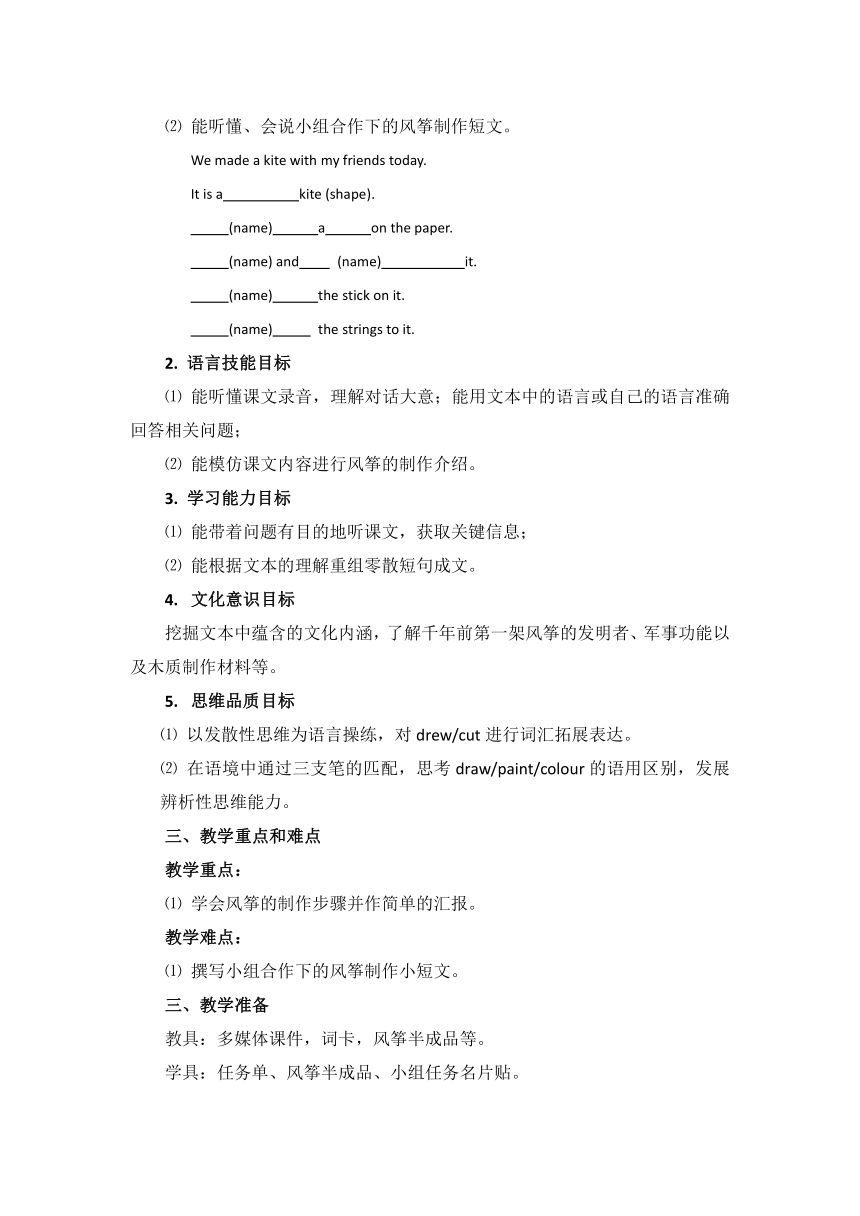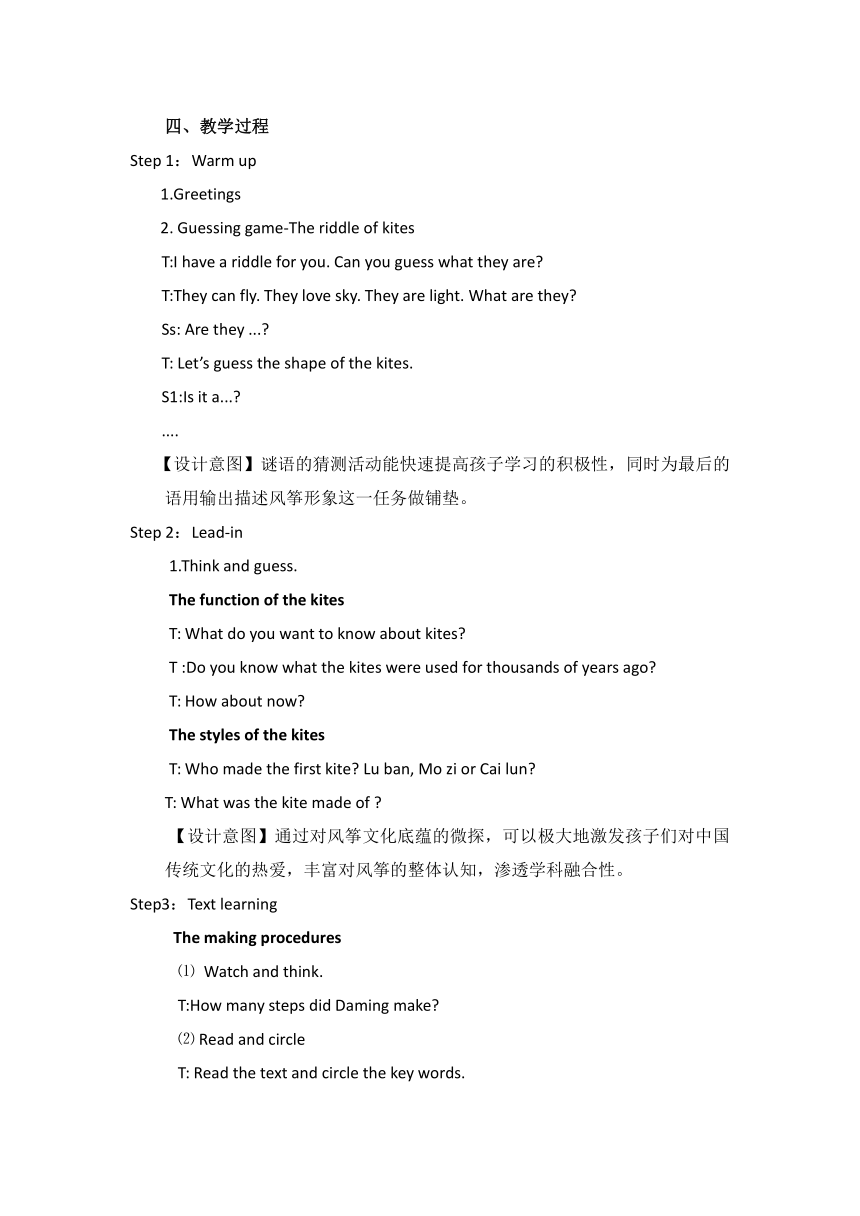Module 8 Unit 2 I made a kite. 教案
文档属性
| 名称 | Module 8 Unit 2 I made a kite. 教案 |  | |
| 格式 | doc | ||
| 文件大小 | 57.5KB | ||
| 资源类型 | 教案 | ||
| 版本资源 | 外研版(一年级起点) | ||
| 科目 | 英语 | ||
| 更新时间 | 2022-03-21 23:25:18 | ||
图片预览



文档简介
外研版《英语(新标准)》五年级下册
Module 8 Unit 2 I made a kite. 教学设计
一、教学内容与学情分析
1.教学内容与整体设计思路
本课教学内容出自新标准《英语》(一起)五年级下册 Module 8 Unit2。整个模块的文本内容为:Daming想为远在纽约的堂兄弟Simon送上一份伴手礼。Fangfang给了他一些建议。最后决定做一个龙风筝作为特殊礼物送出。当他制作完成后进行了简要的回顾和记录。从语言形态上看,Unit1是以一般将来时态讨论计划,Unit2的语言呈现形式是过去式。但是Unit2教材中也提供了以一般现在时为语言支撑下的风筝和剪纸制作的一般步骤,以及对计划的讨论练习。
从文化意识的维度落实上,通过Unit1的学习,学生了解到中国的传统文化因互鉴而丰富,因交流而精彩。知道除了风筝之外,还有许多具有中国传统特色的伴手礼如,茶叶、木偶、团扇、窗花等等。能进行有效的推荐并作出反应。那么如何进行有效的单元整体设计,挖掘Unit2文本中蕴含的文化内涵是本课的教学难点。(如:第一个风筝是谁发明的?千年前的风筝用途是什么?制作的材质又有哪些不同?)而帮助学生学会风筝的制作步骤并作简单的记录是本课的重点。结合我校的研究课题,备课组从具有思维度的语用型教学策略入手,搭设语言支架,帮助学生在学习风筝制作过程介绍的同时,感受风筝背后丰富的文化底蕴。最后以“基于小组合作下的风筝制作”为主题的小短文撰写和汇报来检测学生的语用能力。
2.学生情况分析
小学五年级的学生通过多年的语言学习,已经具备了一定的语言积累,对过去式的表达有一定的基础。同时,在第一单元的学习后,对风筝制作的基本流程有了一定的认识,能在教师的帮助下学会记录和汇报风筝的制作过程。
二、教学目标
1.语言知识目标
⑴ 大部分同学能听懂、会说、认读单词及词组:
drew / painted / cut / put / string/ tie
put...on... tie string to...
⑵ 能听懂、会说小组合作下的风筝制作短文。
We made a kite with my friends today.
It is a kite (shape).
(name) a on the paper.
(name) and (name) it.
(name) the stick on it.
(name) the strings to it.
2. 语言技能目标
⑴ 能听懂课文录音,理解对话大意;能用文本中的语言或自己的语言准确回答相关问题;
⑵ 能模仿课文内容进行风筝的制作介绍。
3. 学习能力目标
⑴ 能带着问题有目的地听课文,获取关键信息;
⑵ 能根据文本的理解重组零散短句成文。
4. 文化意识目标
挖掘文本中蕴含的文化内涵,了解千年前第一架风筝的发明者、军事功能以及木质制作材料等。
5. 思维品质目标
⑴ 以发散性思维为语言操练,对drew/cut进行词汇拓展表达。
⑵ 在语境中通过三支笔的匹配,思考draw/paint/colour的语用区别,发展辨析性思维能力。
三、教学重点和难点
教学重点:
⑴ 学会风筝的制作步骤并作简单的汇报。
教学难点:
⑴ 撰写小组合作下的风筝制作小短文。
三、教学准备
教具:多媒体课件,词卡,风筝半成品等。
学具:任务单、风筝半成品、小组任务名片贴。
四、教学过程
Step 1:Warm up
1.Greetings
2. Guessing game-The riddle of kites
T:I have a riddle for you. Can you guess what they are
T:They can fly. They love sky. They are light. What are they
Ss: Are they ...
T: Let’s guess the shape of the kites.
S1:Is it a...
....
【设计意图】谜语的猜测活动能快速提高孩子学习的积极性,同时为最后的语用输出描述风筝形象这一任务做铺垫。
Step 2:Lead-in
1.Think and guess.
The function of the kites
T: What do you want to know about kites
T :Do you know what the kites were used for thousands of years ago
T: How about now
The styles of the kites
T: Who made the first kite Lu ban, Mo zi or Cai lun
T: What was the kite made of
【设计意图】通过对风筝文化底蕴的微探,可以极大地激发孩子们对中国传统文化的热爱,丰富对风筝的整体认知,渗透学科融合性。
Step3:Text learning
The making procedures
⑴ Watch and think.
T:How many steps did Daming make
⑵ Read and circle
T: Read the text and circle the key words.
⑶ Read and check
Drew-(T write down the word on the blackboard, then teach the phonics.)
T:I drew a butterfly kite. What did you draw in your art lesson
S1:I drew a...
Painted -(T write down the word on the blackboard, then teach the phonics.)
T:Can we paint the kite with pencil
S1: No.
T:What kinds of pen are good for painting
...
Cut -(T write down the word on the blackboard, then teach the phonics.)
T: We cut the paper with scissors.
T:If you have a pair of scissors what do you want to cut
S1: Cut the hair.
S2: Cut the paper.
S3: Cut the rope.
S4: cut the fingernail.
....
Put sticks on...
T:Look,this is a stick. These are ....
Ss: Sticks.
T: Now, I put sticks on the desk. Where do you want to put them on
S1: I put sticks on the book.
T: He put them on the book. Pay attention to this word,Put-put.
Tie strings to...
⑴ Think and say
T: Which one is the rope And Which one is the string
T: Now , let’s have a race to tie the shoestring.
T: Tie the shoestring is easy. Can you tie the string to the kite Who want to try
【设计意图】: 围绕风筝制作关键词的核对为任务线索,引导学生以发散性思维拓展方式结合语言操练,对drew/cut/Put sticks on...进行有意义的词汇与句型的拓展表达。在语境中通过三支笔的匹配,思考draw/paint/colour的语用区别,发展辨析性思维能力,改变文本零散词汇的枯燥度,在深入文本学习的同时提高学习的质(准确表达)与量(拓展用法)。
Step4:Make in correct orders then imitate
⑴ Ss try to make the sentences in correct orders.
⑵ Listen and imitate. Pay more attention to the sound-linking.
【设计意图】: 通过排序活动,检测学生对文本的理解和识记水平。同时加强对文本的跟读技巧训练,尤其是连读部分,为最后的短文汇报朗读做铺垫。
Step 5:Practice
⑴ Discuss, make and say
T: We learnt a lot about kites making. Do you want to make one Now, let’s make a kite with your team members. First, you should have a short discussion and get different tasks. One for reporter. One for painter. Two for colouring. And two for Co members.
T: How do reporter do The reporter should record the team members’ tasks.
Here’s the example:
⑵ Reporters show the reports
【设计意图】: 为加深学生对文本的内化程度,突破对文本文字的设限。
设计了该小组合作做风筝的活动。通过讨论,成员明确各自的分工。在动手制作风筝的同时感受合作的重要性。所推选的记录员应记录下每位成员的任务完成情况,并在小组中汇报反馈。为最后的小短文提供主体分工任务进行示范。
Step 6:Production
⑴ Write and say
Ss try to finish their record card below:
I made a kite with my friends today.
It is a kite (shape).
I .
My friends (name) a on the paper.
(name) and (name) it.
(name) the stick on it.
(name) the strings to it.
Our kite is very .
We will fly the kite in day(weather),
We will fly it in the .(place)
Do you want to join us
【设计意图】:通过的思维活动,引导孩子们用思维迁移的方式,尝试介绍风筝的制作要点,表达风筝放飞的计划和并作邀请。
该活动能检测与发展孩子综合语言运用的能力。
Step 7: Summary
T:You did a great job! I think you’re all fantastic! A big hand for yourselves!
五、板书设计:
I am a recorder today.
We made a kite (shape).
(name) a on the paper.
(name) and (name) it.
(name) the stick on it.
(name) the strings to it.
We did a good job.
drew a ...
Painted it
cut the paper
Put sticks on...
Tied the strings to...
Module 8 Unit2
I made a kite.
drew
Module 8 Unit 2 I made a kite. 教学设计
一、教学内容与学情分析
1.教学内容与整体设计思路
本课教学内容出自新标准《英语》(一起)五年级下册 Module 8 Unit2。整个模块的文本内容为:Daming想为远在纽约的堂兄弟Simon送上一份伴手礼。Fangfang给了他一些建议。最后决定做一个龙风筝作为特殊礼物送出。当他制作完成后进行了简要的回顾和记录。从语言形态上看,Unit1是以一般将来时态讨论计划,Unit2的语言呈现形式是过去式。但是Unit2教材中也提供了以一般现在时为语言支撑下的风筝和剪纸制作的一般步骤,以及对计划的讨论练习。
从文化意识的维度落实上,通过Unit1的学习,学生了解到中国的传统文化因互鉴而丰富,因交流而精彩。知道除了风筝之外,还有许多具有中国传统特色的伴手礼如,茶叶、木偶、团扇、窗花等等。能进行有效的推荐并作出反应。那么如何进行有效的单元整体设计,挖掘Unit2文本中蕴含的文化内涵是本课的教学难点。(如:第一个风筝是谁发明的?千年前的风筝用途是什么?制作的材质又有哪些不同?)而帮助学生学会风筝的制作步骤并作简单的记录是本课的重点。结合我校的研究课题,备课组从具有思维度的语用型教学策略入手,搭设语言支架,帮助学生在学习风筝制作过程介绍的同时,感受风筝背后丰富的文化底蕴。最后以“基于小组合作下的风筝制作”为主题的小短文撰写和汇报来检测学生的语用能力。
2.学生情况分析
小学五年级的学生通过多年的语言学习,已经具备了一定的语言积累,对过去式的表达有一定的基础。同时,在第一单元的学习后,对风筝制作的基本流程有了一定的认识,能在教师的帮助下学会记录和汇报风筝的制作过程。
二、教学目标
1.语言知识目标
⑴ 大部分同学能听懂、会说、认读单词及词组:
drew / painted / cut / put / string/ tie
put...on... tie string to...
⑵ 能听懂、会说小组合作下的风筝制作短文。
We made a kite with my friends today.
It is a kite (shape).
(name) a on the paper.
(name) and (name) it.
(name) the stick on it.
(name) the strings to it.
2. 语言技能目标
⑴ 能听懂课文录音,理解对话大意;能用文本中的语言或自己的语言准确回答相关问题;
⑵ 能模仿课文内容进行风筝的制作介绍。
3. 学习能力目标
⑴ 能带着问题有目的地听课文,获取关键信息;
⑵ 能根据文本的理解重组零散短句成文。
4. 文化意识目标
挖掘文本中蕴含的文化内涵,了解千年前第一架风筝的发明者、军事功能以及木质制作材料等。
5. 思维品质目标
⑴ 以发散性思维为语言操练,对drew/cut进行词汇拓展表达。
⑵ 在语境中通过三支笔的匹配,思考draw/paint/colour的语用区别,发展辨析性思维能力。
三、教学重点和难点
教学重点:
⑴ 学会风筝的制作步骤并作简单的汇报。
教学难点:
⑴ 撰写小组合作下的风筝制作小短文。
三、教学准备
教具:多媒体课件,词卡,风筝半成品等。
学具:任务单、风筝半成品、小组任务名片贴。
四、教学过程
Step 1:Warm up
1.Greetings
2. Guessing game-The riddle of kites
T:I have a riddle for you. Can you guess what they are
T:They can fly. They love sky. They are light. What are they
Ss: Are they ...
T: Let’s guess the shape of the kites.
S1:Is it a...
....
【设计意图】谜语的猜测活动能快速提高孩子学习的积极性,同时为最后的语用输出描述风筝形象这一任务做铺垫。
Step 2:Lead-in
1.Think and guess.
The function of the kites
T: What do you want to know about kites
T :Do you know what the kites were used for thousands of years ago
T: How about now
The styles of the kites
T: Who made the first kite Lu ban, Mo zi or Cai lun
T: What was the kite made of
【设计意图】通过对风筝文化底蕴的微探,可以极大地激发孩子们对中国传统文化的热爱,丰富对风筝的整体认知,渗透学科融合性。
Step3:Text learning
The making procedures
⑴ Watch and think.
T:How many steps did Daming make
⑵ Read and circle
T: Read the text and circle the key words.
⑶ Read and check
Drew-(T write down the word on the blackboard, then teach the phonics.)
T:I drew a butterfly kite. What did you draw in your art lesson
S1:I drew a...
Painted -(T write down the word on the blackboard, then teach the phonics.)
T:Can we paint the kite with pencil
S1: No.
T:What kinds of pen are good for painting
...
Cut -(T write down the word on the blackboard, then teach the phonics.)
T: We cut the paper with scissors.
T:If you have a pair of scissors what do you want to cut
S1: Cut the hair.
S2: Cut the paper.
S3: Cut the rope.
S4: cut the fingernail.
....
Put sticks on...
T:Look,this is a stick. These are ....
Ss: Sticks.
T: Now, I put sticks on the desk. Where do you want to put them on
S1: I put sticks on the book.
T: He put them on the book. Pay attention to this word,Put-put.
Tie strings to...
⑴ Think and say
T: Which one is the rope And Which one is the string
T: Now , let’s have a race to tie the shoestring.
T: Tie the shoestring is easy. Can you tie the string to the kite Who want to try
【设计意图】: 围绕风筝制作关键词的核对为任务线索,引导学生以发散性思维拓展方式结合语言操练,对drew/cut/Put sticks on...进行有意义的词汇与句型的拓展表达。在语境中通过三支笔的匹配,思考draw/paint/colour的语用区别,发展辨析性思维能力,改变文本零散词汇的枯燥度,在深入文本学习的同时提高学习的质(准确表达)与量(拓展用法)。
Step4:Make in correct orders then imitate
⑴ Ss try to make the sentences in correct orders.
⑵ Listen and imitate. Pay more attention to the sound-linking.
【设计意图】: 通过排序活动,检测学生对文本的理解和识记水平。同时加强对文本的跟读技巧训练,尤其是连读部分,为最后的短文汇报朗读做铺垫。
Step 5:Practice
⑴ Discuss, make and say
T: We learnt a lot about kites making. Do you want to make one Now, let’s make a kite with your team members. First, you should have a short discussion and get different tasks. One for reporter. One for painter. Two for colouring. And two for Co members.
T: How do reporter do The reporter should record the team members’ tasks.
Here’s the example:
⑵ Reporters show the reports
【设计意图】: 为加深学生对文本的内化程度,突破对文本文字的设限。
设计了该小组合作做风筝的活动。通过讨论,成员明确各自的分工。在动手制作风筝的同时感受合作的重要性。所推选的记录员应记录下每位成员的任务完成情况,并在小组中汇报反馈。为最后的小短文提供主体分工任务进行示范。
Step 6:Production
⑴ Write and say
Ss try to finish their record card below:
I made a kite with my friends today.
It is a kite (shape).
I .
My friends (name) a on the paper.
(name) and (name) it.
(name) the stick on it.
(name) the strings to it.
Our kite is very .
We will fly the kite in day(weather),
We will fly it in the .(place)
Do you want to join us
【设计意图】:通过的思维活动,引导孩子们用思维迁移的方式,尝试介绍风筝的制作要点,表达风筝放飞的计划和并作邀请。
该活动能检测与发展孩子综合语言运用的能力。
Step 7: Summary
T:You did a great job! I think you’re all fantastic! A big hand for yourselves!
五、板书设计:
I am a recorder today.
We made a kite (shape).
(name) a on the paper.
(name) and (name) it.
(name) the stick on it.
(name) the strings to it.
We did a good job.
drew a ...
Painted it
cut the paper
Put sticks on...
Tied the strings to...
Module 8 Unit2
I made a kite.
drew
同课章节目录
- Module 1
- Unit 1 She was a driver before.
- Unit 2 He worked in an office .
- Module 2
- Unit 1 What did she have for lunch?
- Unit 2 Lunch is usually at half past twelve.
- Module 3
- Unit 1 Have you got the Harry Potter DVDs?
- Unit 2 You can use the computers.
- Module 4
- Unit 1 Did you read them?
- Unit 2 My favourite season is spring.
- Module 5
- Unit 1 Your bag is broken.
- Unit 2 Mine is pink.
- Module 6
- Unit 1 We' ll see lots of very big stones.
- Unit 2 It was amazing.
- Module 7
- Unit 1 My father goes to work at 8 o'clock every m
- Unit 2 I'll be home at 7 o’clock.
- Module 8
- Unit 1 Will you help me ?
- Unit 2 I made a kite.
- Module 9
- Unit 1 We laughed a lot.
- Unit 2 Mum bought new chopsticks for you.
- Module 10
- Unit 1 What did you put in your bag ?
- Unit 2 I played on the beach.
- Review Module
- Unit 1
- Unit 2
